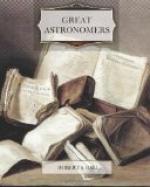[Plate: Lord Rosse’s telescope. From a photograph by W. Lawrence, Upper Sackville Street, Dublin.]
The first duty that Lord Rosse had to undertake was the construction of this tremendous mirror, six feet across, and about four or five inches thick. The dimensions were far in excess of those which had been contemplated in any previous attempt of the same kind. Herschel had no doubt fashioned one mirror of four feet in diameter, and many others of smaller dimensions, but the processes which he employed had never been fully published, and it was obvious that, with a large increase in dimensions, great additional difficulties had to be encountered. Difficulties began at the very commencement of the process, and were experienced in one form or another at every subsequent stage. In the first place, the mere casting of a great disc of this mixture of tin and copper, weighing something like three or four tons, involved very troublesome problems. No doubt a casting of this size, if the material had been, for example, iron, would have offered no difficulties beyond those with which every practical founder is well acquainted, and which he has to encounter daily in the course of his ordinary work. But speculum metal is a material of a very intractable description. There is, of course, no practical difficulty in melting the copper, nor in adding the proper proportion of tin when the copper has been melted. There may be no great difficulty in arranging an organization by which several crucibles, filled with the molten material, shall be poured simultaneously so as to obtain the requisite mass of metal, but from




